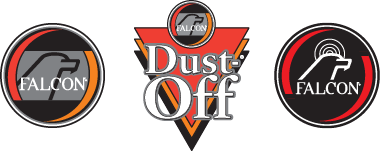PERSONAL FLOTATION DEVICES (PFDS)
- Have at least one Coast Guard-approved device per passenger and a minimum of two on board.
- An additional throwable device is required if the vessel is more than 16 feet long.
- Explain the location and use of all PFDs to passengers and crew that may be new to the vessel.
SOUND PRODUCING DEVICES
- Have a horn capable of producing a four-second blast audible for at least 1/2 mile on board.
- If you use portable air horn, have a spare can of air or an alternate device. (Falcon recommends our FC4N and the Refill FNR).
- Attach a whistle to each PFD.
LIGHTS AND SHAPES
- Have all navigation lights as required for your boat.
- Make sure all instrument lights are working.
- If you intend to engage in a recreational boating activity that requires a day-shape, have the required shapes.
- Have aboard a flashlight and spare batteries.
DISTRESS SIGNALS
- Make flares, day signals, etc., accessible and ensure they are stored in a dry location.
- Carry signals at all times even if not required by the Coast Guard.
- Inform the crew and passengers of their location and safety rules for proper usage.
TOOLS AND SPARES
- Carry a basic toolbox with tools appropriate for your boat.
- Carry a box of spares including fuel filter, light bulbs, head parts, through-hull plugs, etc.
FUEL AND OIL
- Top off your fuel tanks.
- If you can’t, have enough fuel to provide a reasonable margin of safety for your return.
- Check the engine oil and coolant levels.
FIRE EXTINGUISHERS
- Carry at least one fire extinguisher and make sure it is accessible. Make sure you have at least the number required by Coast Guard rules. If you do not, click here to find suitable fire extinguishers.
- Make sure there are fire equipment signs surrounding the equipment so that the equipment is visible and people know how to use it properly.
- Check to be sure mounts are secure and functional before departure.
- Take the time to point out locations to passengers and crew.
VENTILATION
- On any powered vessel or auxiliary powered sailboat, or vessels using LPG for cooking or heat, check that all interior spaces are well ventilated before departure.
- If fuel smells are detected before ventilating, check after running the blowers for several minutes before starting.
- If odor persists, shut down the engine and look for the source of the leak.
BILGES
- Check to be sure bilges are reasonably dry and that pumps are not running excessively.
- Clean up any spilled oil or waste in bilges to prevent overboard discharge.
WEATHER FORECAST
- Always check the weather forecast before boating.
- Have a radio on board to receive weather updates.
BATTERY CARE
- If you have a dual charging system, make sure the selector switch in the proper position.
- Make sure the power is on to the entire vessel.
- Have aboard spare batteries for accessories such as your handheld radio, flashlight, portable navigational aid, etc.
- If the batteries are rechargeable, make sure they’re charged.
DOCKING AND ANCHORING TIPS
- Make sure your aluminum gangway is securely set up and of good quality.
- Have at least one anchor set up and bent-on to your anchor line.
- Carry two or three extra dock lines in case you encounter unusual conditions dockside.
- Visually inspect the lines you use for chafe or wear.
- Carry at least two fenders on-board for docking or towing if required.
RULES & DOCUMENTATION
- Have the ship’s papers, radio license, fishing permit, etc. on board.
- Have the chart or charts for the area you intend to cruise in, regardless of your level of local knowledge


